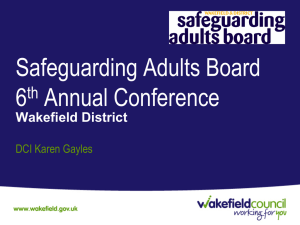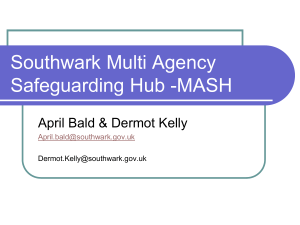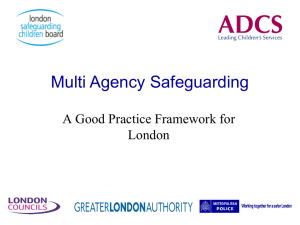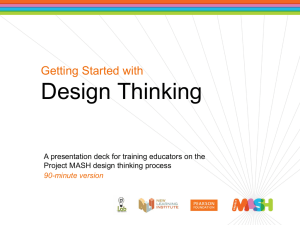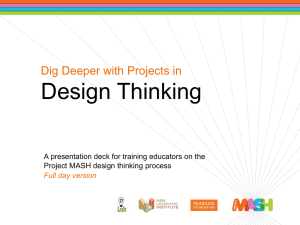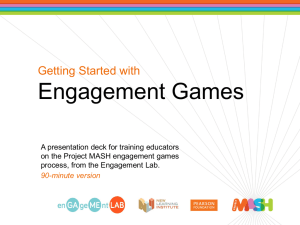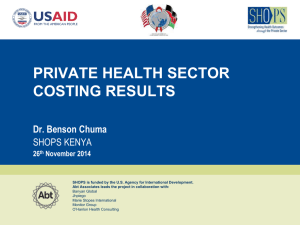Understanding Multi-Agency Safeguarding Hubs
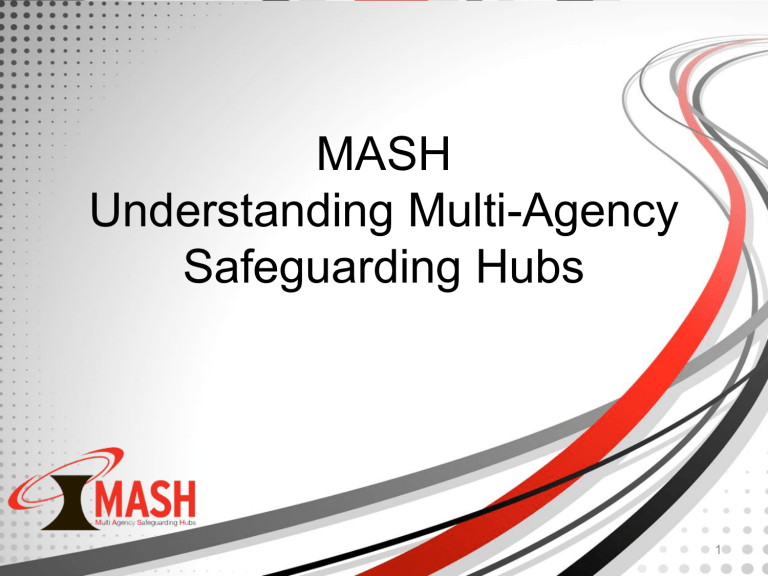
MASH
Understanding Multi-Agency
Safeguarding Hubs
1
What is a MASH?
MASH is the forum for different agencies to work together in a common way across London
• The MASH brings together a core membership which includes Children’s Social
Care, Police, Probation, Mental Health, Education, Housing, Youth Offending Service and Health. These agencies are key components to the process which must encourage them to share fully, and to build bridges to key decision makers e.g. Head teachers
• The aim of the MASH is Prevention - to identify risk and harm to allow timely and appropriate interventions
• The MASH provides a co-location which allows the tension between privacy and sharing information to be undertaken safely and is seen as a key tool to building strong partnership work to identify vulnerable children earlier.
•
The MASH provides a common process, which is adapted to fit locally, to allow clarity on sharing within and between boroughs
• The MASH will allow for the system to link into Adult services
2
Essential Criteria for a Mash
There are five core elements that must be included:
1.
All notifications relating to safeguarding and promoting the welfare of children go through the hub
2.
Co-location of professionals from core agencies
3.
The hub is fire walled, keeping MASH activity confidential and separate from operational activity
4.
An agreed process for analysing and assessing risk, based on the fullest information picture and dissemination of a suitable information product to the most appropriate agency for necessary action
5.
A process to identify those vulnerable or at risk of emerging harm through research and analysis
Barnet Children’s Social Care
MASH structure chart
• Erica Ferrari: Service Manager, Children’s Assessment Service
(MASH lead)
• Jackie Stroud: MASH Team Manager, Children Social Care. One additional team manager to be appointed on a temporary basis
• Experienced Social workers x 2
• Social Work Assistants (Researchers) X 4.6
• Duty Support Officers x 4.6
4
BARNET MASH Phase 1,2 & 3
• Phase 1 is operating in Building 4,NLBP. Police
Sergeant from the Public Protection Desk, Duty team administrator & Social Worker co-located to process
Merlins with Team Manager oversight.
• Phase 2 , on target to go by the end of July. All agencies will be co-located in the MASH suite situated on the ground floor of Building 2, North London Business Park.
• Phase 3, will include vulnerable adults. Discussions to take this forward will begin following the launch of Phase
2. The MASH suite of rooms includes additional capacity to accommodate professionals from adult services for
Phase 3.
5
Day to Day Operation
• The Children Social Care Team Manager for MASH will have day to day management responsibility for the
MASH. However line management arrangements do not change for partner agencies
• Each agency will be able to access their own systems in the MASH in order to share information. In Barnet discussion is in progress to agree a system whereby several agencies such as Children Social Care & the
Police will be able to check the front page of partner agency systems to establish if a family is known.
Partners in the BARNET MASH
To be a MASH, it is a requirement that, as a minimum, the following partners are co-located: Children Social Care, Police, Health,
Education ,Probation, Housing & Youth Offending.
Barnet MASH will have access to all these partner systems, direct access to duty lines and a daily/ weekly presence of dedicated professionals from each agency.
In addition Barnet MASH will have representation in the MASH from
Barnet’s Early Intervention Services (CAF, IFF, DV project), cahms,
Adult Social Care, Adult Mental Health & Drugs & Alcohol services and the Voluntary Sector .
7
How will the MASH process work in Barnet?
• Single point of referral for all concerns regarding children & young people to children social care including the disabled children’s team, hospital team, early intervention services, YOS court list & TYS.
• Initial screening by Duty Support Officer. If child / family known, sent to allocated social worker
• If not an open case a new contact will be recorded
• Experienced social worker will give an initial BRAG rating in accordance with the MASH risk threshold document & attached time scales for action
• Social Work Assistants will research appropriate cases
• MASH manager & PPD police sergeant oversee and are responsible for the MASH process, meetings & outcome determination. They can change the BRAG rating at any point dependent on information received.
8
Guide to BRAG ratings
• RED: Child or YP appears to be at risk of immediate/ or serious harm. S47 enquiry likely. Action: As soon as possible but within 4 hours. Referred to CAIT & CSC duty team immediately.
• AMBER: Child or YP at risk of harm, no immediate urgent action. S47 investigation possible but more likely s17. Action:
As soon as possible but within 24 hours
• GREEN: Concerns about the well being of a child or YP, which if not addressed may lead to poor outcomes. May be s17 or a CAF. Action: ASAP but within 2 working days
• BLUE : Children with no additional needs & whose developmental needs are met by universal services but who may benefit form single agency support. Action: same day, no checks required
MERLIN
(See separate process)
Multi-agency
MASH process:
Self Anonymous
Other local authority referral
MASH
4 hour target
MASH
24 hour target
MASH
2 day target
BRAG rate
Review and summary of collated information
Decision making final
BRAG rating
Check protocol
ICS
Check eCAF
New case created on protocol
Initial screening on whether to
MASH
Open social care case: details sent to case worker
CSC CAF
Advice and info
Single agency response
NFA
10
How will the MASH make a difference?
• There is continuing theme of repeat identification in Serious Case
Reviews regarding lack of communication & information sharing between agencies.
• MASH will seek to overcome these failings by bringing professionals together in an environment where information can be shared fully & safely with all professional taking joint responsibility for risk assessments.
• The interface between professionals from partner agencies will facilitate the development of professional relationships & dialogue, provide support, collaborative working and confidence to understand, discuss & challenge decisions.
• Having one ‘front door’ for all concerns about vulnerable children and young people will ensure simplicity and clarity for referrers.
Action following referrals are determined following discussion with all relevant agencies & fed back to the referrer.
